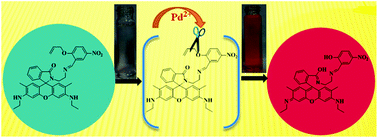A fluorescence ‘turn-on’ chemodosimeter for the specific detection of Pd2+ by a rhodamine appended Schiff base and its application in live cell imaging†
Abstract
A new rhodamine based allyl-ether Schiff base (RD) was spectroscopically characterized and used as a colorimetric and fluorimetric sensor. RD acts as turn-on highly selective fluorescent chemosensor for Pd(II) from only a mixture of Pd(0) and Pd(II) in the presence of 25 other cations in aqueous-acetonitrile medium. The mechanism for Pd(II) sensing with RD involves Pd(II)-triggered terminal (C–O)-allyl bond cleavage followed by opening of the spirolactam ring. Pd(II) is allylphilic and the (rhodamine)O-allyl moiety selects Pd(II) from the mixture (Pd(0) + Pd(II)), and a fluorescence enhancement is observed. The proposal has been supported by spectroscopic data (FTIR, 1H NMR, 13C NMR, and mass spectroscopy). It is again supported by examining the Pd(II) selectivity of an non-allylated rhodamine appended iminephenol (RD′), which failed to selectively detect Pd(II). Hence, the presence of the allylether is mandatory in the fluorogenic motif for Pd(II) selectivity. The limit of detection (LOD) of Pd(II) by RD is 50 nM at pH 7.4. Fluorescence microscopic studies help in imaging the cellular uptake of Pd2+ at the nM level in the HCT116 (Human colorectal carcinoma) cell line.



 Please wait while we load your content...
Please wait while we load your content...